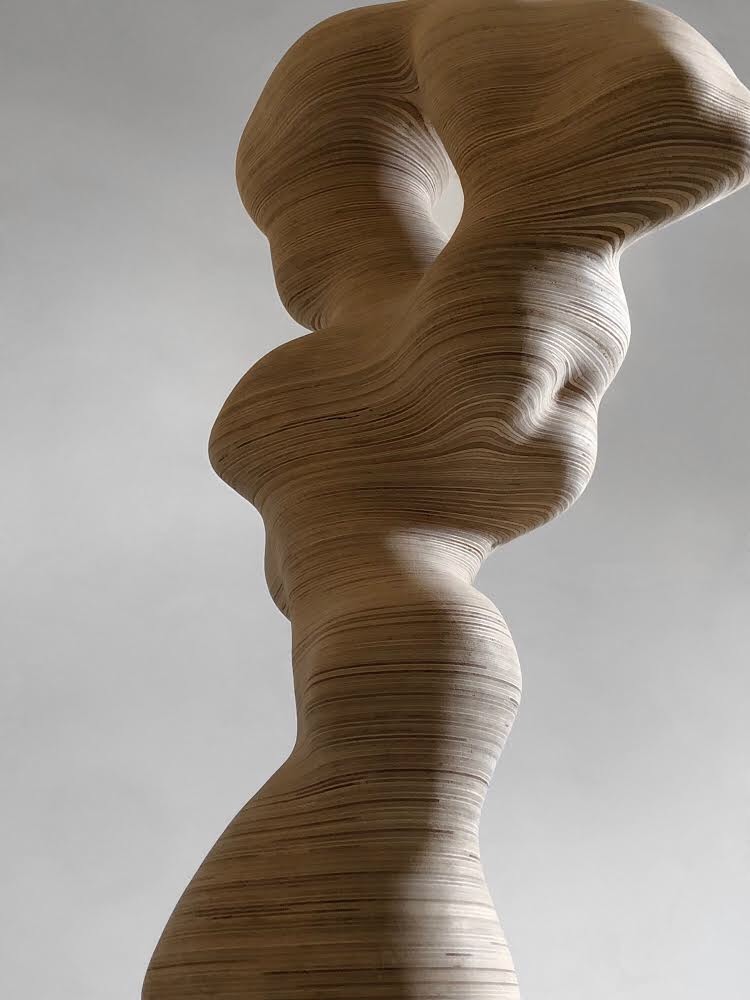In his first ever exhibition, Danny Fotopoulos presents abstract
sculptures alongside recent graduate Joseph Häxan’s photographs of the human
form.
Fotopoulos’ biomorphic sculptural works echo
organic forms found in nature and express the connection between nature and
humanity. He includes large-scale plywood sculptures as well as small-scale
bronze works. His work fuses traditional figure sculpture and modern abstract
art, creating shapes to imitate the curves and contours of the human form in
order to give the sculptures an organic, life-like quality.
“I have always enjoyed figurative sculpture but always liked
creating abstract designs, so my practice is a combination of those two aspects
of art,” says Fotopoulos.
He starts with a clay model of his desired form and then creates a
3D model of it. Using a computer program he breaks the model down into
individual layers that are printed out and used as templates to cut out
plywood. These plywood shapes are then restacked like steps to recreate the
sculpture, which is then smoothed and carved out. This technique helps create
forms that reflect the shapes and patterns found in nature.
Häxan’s photographs have a sculptural body element to them and
pair well with Fotopoulos’ works. Although he doesn’t refer to his works as
self-portraiture, Häxan uses himself as a model in his photographs, which
depict scenes of debased human interaction and hysteria, lit by a sterile and
punishing white light.
 Danny Fotopoulos, Yineka
Danny Fotopoulos, Yineka
“When you look at the works with lots of people in them, I like to
focus on having a lot of interesting interactions between the characters. I
think that is way more interesting than looking at bodies in weird poses,” he
explains. “The spaces in between the people are more important to the story
telling or thematics of the works than the people themselves.”
The work on display is mostly from Häxan’s older series, Body
Horror – named after a film genre of horror focusing on body
transfigurations, such as the transformation from humans into werewolves. The
exhibition also includes new works from the series the Rite of Spring.
“I have been working on the previous series, Body Horror, for
over two years, so it’s like a closing ceremony for Body Horror and a
welcoming for the next series,” explains Häxan.
The Rite of Spring makes reference to Igor Stravinsky’s
orchestral composition of the same name, and its use in Walt Disney’s Fantasia,
which depicts the processes of the young earth’s evolution and regeneration
after catastrophic events.
While the past couple of series Häxan has worked on have had
similar themes he distinguishes them through the techniques used to make them.
For example, Body Horror was made with a speedlight camera flash which
sits atop a camera. The Rite of Spring is a move away from this: Häxan
has detached the flash so the light source is away from the camera itself.
Häxan says, “The light in the works plays a role – it’s embodying
the audience itself. It’s important because the light is now detached from the
camera so the camera isn’t the audience any more.”
Danny Fotopoulos: Organic Forms
Joseph Haxan: Rite of Spring
GAGPROJECTS
Until 24 November 2019
Get the latest from The Adelaide Review in your inbox
Get the latest from The Adelaide Review in your inbox